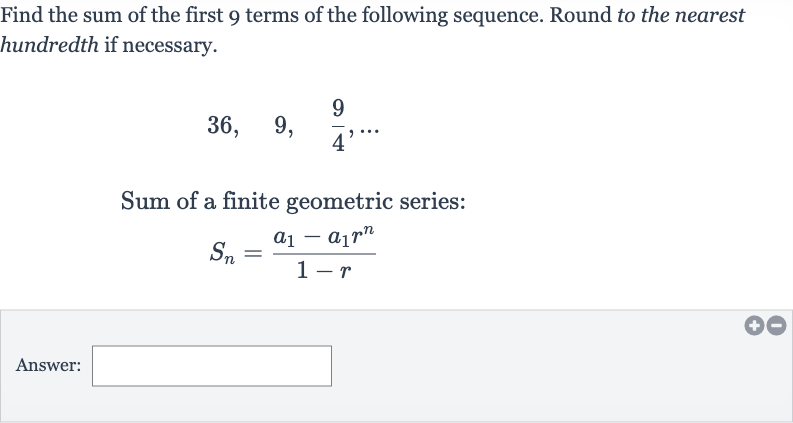Full solution
Q. Find the sum of the first terms of the following sequence. Round to the nearest hundredth if necessary.Sum of a finite geometric series:Answer:
- Identify Sequence Type: To find the sum of the first terms of the given sequence, we first need to identify the type of sequence. The sequence provided is a geometric sequence because each term is obtained by multiplying the previous term by a common ratio. To find this common ratio , we divide the second term by the first term.
- Calculate Common Ratio: Calculate the common ratio :
- Use Geometric Series Formula: Now that we have the common ratio, we can use the formula for the sum of the first terms of a geometric series: where is the sum of the first terms, is the first term, is the common ratio, and is the number of terms.
- Find Sum of First Terms: Plug the values into the formula to find the sum of the first terms:
- Calculate Numerator and Denominator: Calculate the numerator and the denominator separately:Numerator: Denominator:
- Calculate Denominator: Calculate the denominator:Denominator =
- Calculate Numerator: Calculate the numerator:Numerator = Since is a very small number, we can use a calculator to find its value and then multiply it by .
- Divide Numerator by Denominator: Using a calculator, we find:Numerator Numerator
- Calculate Final Sum: Now, divide the numerator by the denominator to find the sum:
- Round to Nearest Hundredth: Calculate the final sum:
- Round to Nearest Hundredth: Calculate the final sum:Round the sum to the nearest hundredth:
More problems from Find trigonometric functions using a calculator
QuestionGet tutor help
QuestionGet tutor help
QuestionGet tutor help
QuestionGet tutor help
QuestionGet tutor help
QuestionGet tutor help
Question
. Find the value of in degrees.Write your answer in simplified, rationalized form. Do not round.____
Get tutor helpQuestionGet tutor help

